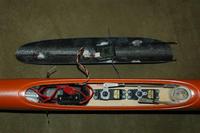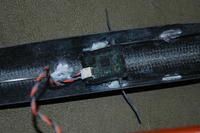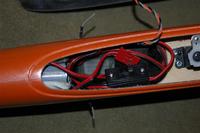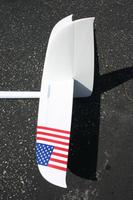|
|
|
|
|
|
|
Hi Tony,
Actually, we got lucky that the more popular radio configuration is Mode 2. I used to fly Mode 1, and that was difficult when launching....at least for me. Okay, so back to the discussion. Several people asked me about the 2.4 Ghz set up I have in the Xplorer. Quite simple, actually. First off, remember that with the ballast tube located where it is, you lose all the space behind the servo tray. That will make the nose rather cramped at best. I planned on using the JR R-921 receiver, until I installed my 2-cell li-ion pack. No dice! I then reverted to the Spektrum AR7000 Rx, which is also quite reliable. It will just fit with the battery I use. (Note: if you use a custom configuration 4-cell nickel based pack, you may have more usable space.) Under the upper cell, which is staggered back to allow the lower cell to push deep into the nose, I was able to slide the Castle Creations BEC unit to regulate the lithium battery at a precise 6.0 volts. Looking at the photos, it's almost impossible to see the AR7000 underneath the main switch. But it is there and the antenna whiskers poke straight away from the Rx out the sides. On the Shadow, I had to extend the antenna wires to allow for enough bare antenna to be outside the fuselage. It was not necessary in this install up front. The AR7000 is capable of using one remote rx, and we placed this up into the carbon canopy, making sure it would not hit the rudder servo or ballast tube. The antenna wires simply poke out the sides. The distance between main Rx and the remote is about 4.5 inches. Although both antenna sets are arranged in the same directions, I have had no problems with different angles. And as you can see, the remote can be disconnected by pulling out the wire plug. (Sorry about the crummy looking white mounds of junk inside the canopy. It seems I can't master flox and CA as yet). That's it and the aircraft has completed a half dozen flights so far. Make sure that with any radio installation, you perform a complete and all around the aircraft range check. Do not place the plane on the ground or near cars and large metal objects as this will screw your range check. My normal range check is 33 paces, and I got 40 with this one. One more note: John Dora in Moreno Valley handed me some custom brass ballast slugs that weigh in at 1.35 oz each. This has allowed me to get a pound of weight inside. I have some 1/2 steel rod that gave basically the same result. I can get better by using lead filled brass tubing, but to be honest, I have never ballasted a model past a pound yet. ImagesView all Images in thread
|
|
|
|
|
|
||
|
|
Quote:
1) Why Lipo? I would be concerned that the abuse that TD and especially F3J landings put on batteries could cause a rupture in the pack. Also most small and medium two cell lipos that can fit into the nose of that plane don't support adjustable amperage charge rates so you are stuck with the charge cycle and if its quite low you cant speed it up like you can with NMH. 2) What have you done to avoid the razor sharp carbon strands inside the nose are cutting your Lipo packs and compromising the chemistry? I cut the leads off of a battery pack and shreded the shrink wrap just moving my pack around the tight nose of my shadow... |
|
|
|
||
|
|
|
|
|
And dont come by Norway to to fly in the cold as Lipo's will let you down not giving the power needed..
But I guess I will supply you with a proper battery if you suddenly have the urge to fly on the ice  And Joe: I will be waiting that 0,5s as I dont want to be spending the whole event fixing planes (you and Cody can do the fix/search for planes stuff). I will be landing 99 and 100's anyhow while you fiddle around in your 95's (internal joke this is for those that wonders). Off to Interglide this weekend |
|
|
|
|
|
|
|
|
Neat
What a neat idea to place the smaller rec in the canopy. Thanks for that!! Brian
|
|
|
|
|
|
|
|
|
Jojo,
After looking at your landing scores at the WC and my landings at the SY cup, you and I both need to take a remedial course in landings! BTW, nobody was searching for airplanes in the NZ tent, that was reserved for the folk that took a few too many chances downwind! Yes, we had to fix a Perfect that went kablooey on tow... but that was the extent of our carnage. Joe PS I've learned a lesson in that I need to be a better thrower to throw for DP. I think his towhook *might* be in front of the trailing edge!!! I really hooked a few of his throws (sorry to the guys in the lane to the right!). |
|
|
|
|
|
LITHIUM ION not Lipo for the language impared.
|
|
|
|
|
|
||
|
|
Quote:
Actually, both designations are correct. Lithium ion batteries describes the broad class of batteries that use lithium as the key component of the electrolyte in the battery, hence the 3.7 volt value for a lithium cell (its redox potential). The "lithium ion" name is now applied to the more traditional configuration with a lithium salt solution or gel based electrolyte. These are found in traditional hard packages (cases) to contain the mobile electrolyte. Lithium polymer batteries are the subset of lithium ion battery chemistry that we most often use in the hobby. In these the electrolyte is a lithium containing polymer, hence the name. These are the long, foil wrapped batteries where the cells are somewhat pliable. Sorry, the chemist in me just keeps popping up. JT |
|
|
|
||
|
|
|
|
|
Stan Boyd is holding landing clinics in Fresno this month. I will let him know you both are interested ;-)
|
|
|
|
|
|
||
|
|
Quote:
We need to practice more turbulent landings. AND in my case practice more my funny brain to be able to perform the last split seconds each round at WC level. I checked a few of your throws for DP and it was not your throws. It was the setup mostly actually (have some video too..) So Mike how is the Xplorer with full brake and turbulent air? Please take a few landings behind a treeline! Jojo |
|
|
|
||
|
|
||
|
|
From Mike Lee:
Quote:
Just wondering what size 2s pack you are using and the C value of those cells. The Best Robert |
|
|
|
|
|
|
Hi Guys,
The lithium battery question. Let me clarify this item: It is a lithium-ION battery, with a rated capacity of 2400-mAh. I use mostly Duralite and sometimes Relion batteries, which are tested before sale. They are capable of short burst output of 10-amps...thus my decision to use the Castle Creations BEC due to the compact size and ability to deliver 10 amps, plus is programmable for the voltage output. For anyone not famliar with these cells, they are not the typical lipo "battery in a bag" style battery. These are hard, armored cells like a nickel-cadmium cell. Beleive me, if I dent one of these cells, there will be a whole lot more to worry about on that plane than a dented cell! Secondly, when I install these cells, I make sure that the placement is final, and then I add a dab of Shoe-Goo adhesive to keep it in place. That way, it won't slide back nor forward. Shards of CF are not a concern to these cells, unless that shard happens to be long enough to bridge from one cell to the next. Another concern mentioned was the charge rate...when the standard charge rate of a Li-Ion cell allows for a full charge from discharged to full in one hour, that's not bad! But, I also know I can make a push on these cells to get 90% capacity in only 30-minutes. Please remember, we are talking about 2400-mAh capacity. At the Spor Yapi Cup, we flew 4-rounds of prelims, plus 3 rounds of 15-minute finals, and I flew about 4 practice flights, and never needed to charge all during my stay in Turkey. I run a digital meter in the cockpit and we went from 8.4 volts to only 7.9 volts from all that flying. Nomimal voltage is 7.4 and the not-to-exceed voltage for me is 7.2 volts. So, we had mondo capacity....who needs to charge? Lastly, flying a li-ion in the cold. The Duralite cells will handle pretty severe weather conditions and suffer only a minor volt/amp depression. Less than 10%. That leaves me with 9-amps and 2100-mAh capacity in sub-zero temps. Now, reality says that Norwegians are a very hardy bunch, and I beleive them. But my chances of flying in sub-zero weather are like....zero to none! (I live in Southern California). Not that I don't doubt you, JoJo. I'm just not too worried about having to fly in your neck of the woods! Thanks, guys! |
|
|
|
|
|
|
|
|
#2 Arrival 2.4
Howdy,
I got a present from NAN in our shipment. I thought I would share some pics.  Good air! Bob |
|
Latest blog entry: 2015
|
|
|
|
|
|
|
Nice! cool touch with the graphics.
sj |
|
|
|
«
Previous Thread
|
Next Thread
»
| Thread Tools | |
| Similar Threads | |||||
| Category | Thread | Thread Starter | Forum | Replies | Last Post |
| Discussion | RADINA 2 by NAN models | Pinci | DLG Hand Launch Gliders & F3K | 38 | Feb 11, 2009 01:58 AM |
| Question | Speed 1.5 /Nan Models. Alex Mini 1.5 setup question | Broncomech | Slope Soaring | 20 | Jul 23, 2008 09:47 PM |
| Discussion | Nan Models Shadow ( sorry for the mistake ) | Chipwillis | Thermal Soaring | 56 | Apr 19, 2007 04:44 PM |








